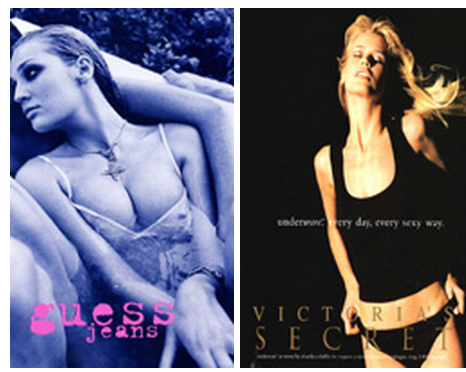Media Effects Research Lab - Research Archive
Sexual suggestiveness in online ads: Effects of objectification on opposite genders
Student Researcher(s)
Sriram Kalyanaraman (Ph.D Candidate);
Michael Redding (B.A. Candidate);
Jason Steele (B.A. Candidate);
Faculty Supervisor
FOR A COMPLETE REPORT OF THIS RESEARCH, SEE:
Kalyanaraman, S., Steele, J., & Sundar S. S. (2000, June). Communicating objectification: Effects of sexually suggestive advertisements. Paper presented to the Mass Communication Division at the 50th annual conference of the International Communication Association (ICA), Acapulco, Mexico.
INTRODUCTION
Current research in the fields of advertising and media effects suggests that men and women react differently to the use of sexual images in advertising campaigns. However, the bulk of the research regarding sexual images in advertising is concerned with marketing issues, such as consumer behavior, product recall and persuausive effectiveness. Little research is aimed at exploring the effects of sexual images in advertising on the perception of the model by the viewer. Also, research concerning the effects of sexual images with male models has largely been ignored. The present investigation examines the relationship between exposure to sexually suggestive mainstream magazine advertisements and the objectification of the gender of the model. Specifically, Study 1 looks at female objectification, while Study 2 examines male objectification.
HYPOTHESES
A summary of research evidence suggests that sexually explicit materials are seen as objectifying and dehumanizing women, portraying women as pandering to men's sexual desires, and encouraging sexual and social suppression of and violence toward women. This leads to the following hypothesis:
H1: Males exposed to sexually suggestive ads featuring female models will indulge in greater objectification of women than those exposed to non-suggestive ads.
Some studies have also shown that women do not indulge in self-objectification after exposure to sexually suggestive material. This leads to the following hypothesis:
H2a: Females exposed to sexually suggestive ads featuring female models will show lesser acceptance of objectification of women than those exposed to non-suggestive ads.
On the other hand, certain other scholars also suggest that women tend to consider themselves as sex objects in their quest to attain ideal female beauty. This gives rise to the following hypothesis:
H2b: Females exposed to sexually suggestive ads featuring female models will show greater acceptance of objectification of women than those exposed to non-suggestive ads.
A considerable body of research also suggests that males tend to indulge in a greater degree of objectification than females. This leads to the following hypothesis:
H3: Across conditions, males will have significantly higher scores of objectification than females.
METHOD
Forty-five participants took part in a 2 (Sexually suggestive ads vs. non-suggestive ads) X 2 (male subjects vs. female subjects) experiment. Participants in both conditions viewed ten ads for different products. The sexually suggestive condition had female models in suggestive poses

while the non-suggestive condition featured female models in non-suggestive positions.
After they had finished viewing the ads, subjects were asked to fill out a questionnaire pertaining to measures of female objectification.
RESULTS
The dependent variable of objectification was divided into three factors labeled 'Sexual Objectification,' 'Mediated Objectification,' and 'Voyeurism.'
H1: Supported. Males exposed to suggestive ads expressed a greater propensity to look at fashion magazines and television shows for the female models rather than the content/designs ('Mediated Objectification'). Furthermore, a significant two-way interaction between gender and suggestiveness was recorded for the Voyeurism index such that male subjects tended to approve of voyeuristic behavior after exposure to suggestive ads than after exposure to non-suggestive ads.
H2a: Not supported.
H2b: Partially supported. Females exposed to suggestive ads expressed greater agreement to look at fashion magazines and television shows for the female models rather than the content/designs ('Mediated Objectification').
H3: Supported. Males tended to perceive women as sex objects, irrespective of the suggestiveness condition, whereas females were significantly less approving of such objectification. Furthermore, males also were significantly more prone to assume the role of 'Peeping Tom,' compared to females, who did not approve of such voyeuristic behavior.
STUDY 2
Study 2 was conducted to determine whether male objectification was similar to female objectification. We also hoped to glean what theoretical mechanisms could have been operating to explain some of the findings from Study 1. Study 2 was similar to Study 1 except that instead of female models, ten ads featuring male models in both sexually suggestive and non-suggestive positions were used as stimulus material.
RESULTS
The dependent variable of objectification was divided into three factors labeled 'Sexual Objectification,' 'Mediated Objectification,' and 'Promiscuity.' Even though the same questinnaire was employed, it was seen that only 'Mediated Objectification' comprised the same measures as in Study 1. The results reveal main effects for gender on both 'Sexual Objectification' and 'Promiscuity,' such that males tended to perecive themselves as sex objects (compared to females). Furthermore, they also had a significantly higher tendency to approve of promiscuous behavior, compared to females.
CONCLUSION
The findings from the two studies suggest that even exposure to seemingly innocuous sexually suggestive ads can lead to disturbing antifemale sentiments such as objectification. An interesting observation was the finding that the constructs of male and female objectification are conceptually distinct. The null findings for 'Mediated Objectification' in Study 2 also suggests the possible operation of the availability heuristic in Study 1. While the effects observed here pertain to short-term effects only, future research will benefit by examining the effects of prolonged exposure to sexually suggestive material.
For more details regarding the study contact
Dr. S. Shyam Sundar by e-mail at sss12@psu.edu or by telephone at (814) 865-2173

